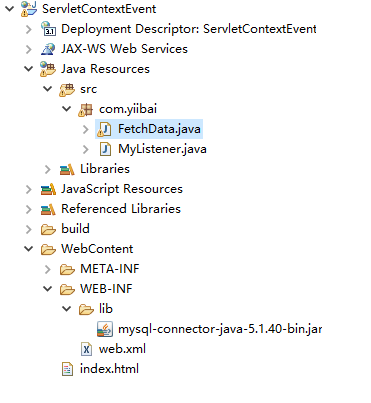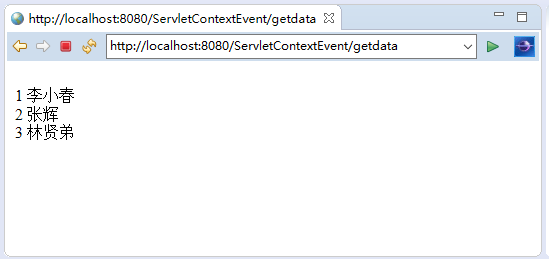Servlet ServletContextEvent事件
當Web應用程序部署在服務器上時,會通知ServletContextEvent事件。
如果要在部署Web應用程序時執行某些操作,例如創建數據庫連接,創建項目的所有表等,則需要實現ServletContextListener接口並提供其方法的實現。
ServletContextEvent類的構造方法
在ServletContextEvent類中只定義了一個構造函數。Web容器在ServletContext實例之後創建ServletContextEvent的實例。
-
ServletContextEvent(ServletContext e)
ServletContextEvent類的方法
ServletContextEvent類中只定義了一個方法:
-
public ServletContext getServletContext()- 返回ServletContext的實例。
ServletContextListener接口的方法
在ServletContextListener接口中聲明瞭兩種方法,這些方法必須由servlet程序員實現,以執行一些操作,如創建數據庫連接等。
-
public void contextInitialized(ServletContextEvent e): 當應用程序部署在服務器上時被調用。 -
public void contextDestroyed(ServletContextEvent e): 當應用程序從服務器取消部署時被調用。
ServletContextEvent和ServletContextListener的示例
在這個例子中,從employees表中檢索數據。爲了實現這個服務,我們在監聽器類中創建了連接數據庫對象,並在servlet中使用了連接對象。
首先,在MySQL中創建一個名稱爲:testdb 的數據庫,創建以下表及以數據記錄 -
DROP TABLE IF EXISTS `employees`;
CREATE TABLE `employees` (
`id` int(10) unsigned NOT NULL AUTO_INCREMENT,
`name` varchar(64) NOT NULL DEFAULT '',
`age` int(3) unsigned NOT NULL DEFAULT '0',
`address` varchar(254) DEFAULT NULL,
`salary` float(8,2) unsigned DEFAULT NULL,
PRIMARY KEY (`id`)
) ENGINE=MyISAM AUTO_INCREMENT=4 DEFAULT CHARSET=utf8;
-- ----------------------------
-- Records of employees
-- ----------------------------
INSERT INTO `employees` VALUES ('1', '李小春', '23', '海口市人民大道1800號', '8900.00');
INSERT INTO `employees` VALUES ('2', '張輝', '28', '廣州天河區珠村市場', '15800.00');
INSERT INTO `employees` VALUES ('3', '林賢弟', '25', '廣州白雲區龍塘村120號', '18990.00');打開Eclipse,創建一個動態Web項目:ServletContextEvent,其完整的目錄結構如下 -

以下是項目中的幾個主要的文件代碼。
文件:index.html -
<!DOCTYPE html>
<html>
<head>
<meta charset="UTF-8">
<title>ServletContextListener實例</title>
</head>
<body style="text-algin: center;">
<a href="getdata">點擊讀取employees表中的數據</a>
</body>
</html>文件:MyListener.java -
package com.yiibai;
import java.sql.Connection;
import java.sql.DriverManager;
import javax.servlet.ServletContext;
import javax.servlet.ServletContextEvent;
import javax.servlet.ServletContextListener;
import javax.servlet.annotation.WebListener;
/**
* Application Lifecycle Listener implementation class MyListener
*
*/
@WebListener
public class MyListener implements ServletContextListener {
public void contextInitialized(ServletContextEvent event) {
String jdbcDriver = "com.mysql.jdbc.Driver";
String dbURL = "jdbc:mysql://localhost/testdb";
// Database credentials
String dbUser = "root";
final String passwd = "123456";
try {
Class.forName(jdbcDriver);
Connection con = DriverManager.getConnection(dbURL, dbUser, passwd);
// storing connection object as an attribute in ServletContext
ServletContext ctx = event.getServletContext();
ctx.setAttribute("mycon", con);
} catch (Exception e) {
e.printStackTrace();
}
}
public void contextDestroyed(ServletContextEvent arg0) {
System.out.println("Servlet has contextDestroyed...");
}
}文件:FetchData.java -
package com.yiibai;
import java.io.IOException;
import java.io.PrintWriter;
import java.sql.Connection;
import java.sql.PreparedStatement;
import java.sql.ResultSet;
import javax.servlet.ServletContext;
import javax.servlet.ServletException;
import javax.servlet.annotation.WebServlet;
import javax.servlet.http.HttpServlet;
import javax.servlet.http.HttpServletRequest;
import javax.servlet.http.HttpServletResponse;
/**
* Servlet implementation class FetchData
*/
public class FetchData extends HttpServlet {
private static final long serialVersionUID = 1L;
/**
* @see HttpServlet#doGet(HttpServletRequest request, HttpServletResponse
* response)
*/
protected void doGet(HttpServletRequest request, HttpServletResponse response)
throws ServletException, IOException {
// TODO Auto-generated method stub
response.setCharacterEncoding("UTF-8");
response.setContentType("text/html;charset=UTF-8");
PrintWriter out = response.getWriter();
try {
// Retrieving connection object from ServletContext object
ServletContext ctx = getServletContext();
Connection con = (Connection) ctx.getAttribute("mycon");
if(con==null) {
System.out.println("獲取數據庫連接異常~!");
}
// retieving data from emp32 table
String sql = "SELECT * FROM employees";
PreparedStatement ps = con.prepareStatement(sql, ResultSet.TYPE_SCROLL_SENSITIVE,
ResultSet.CONCUR_UPDATABLE);
ResultSet rs = ps.executeQuery();
while (rs.next()) {
out.print("<br>" + rs.getString(1) + " " + rs.getString(2));
}
con.close();
} catch (Exception e) {
e.printStackTrace();
}
out.close();
}
}文件:web.xml -
<?xml version="1.0" encoding="UTF-8"?>
<web-app xmlns:xsi="http://www.w3.org/2001/XMLSchema-instance"
xmlns="http://xmlns.jcp.org/xml/ns/javaee"
xsi:schemaLocation="http://xmlns.jcp.org/xml/ns/javaee http://xmlns.jcp.org/xml/ns/javaee/web-app_3_1.xsd"
id="WebApp_ID" version="3.1">
<display-name>ServletContextEvent</display-name>
<welcome-file-list>
<welcome-file>index.html</welcome-file>
<welcome-file>index.jsp</welcome-file>
</welcome-file-list>
<listener>
<listener-class>com.yiibai.MyListener</listener-class>
</listener>
<servlet>
<servlet-name>FetchDataServlet</servlet-name>
<servlet-class>com.yiibai.FetchData</servlet-class>
</servlet>
<servlet-mapping>
<servlet-name>FetchDataServlet</servlet-name>
<url-pattern>/getdata</url-pattern>
</servlet-mapping>
</web-app>在編寫上面代碼後,部署此Web應用程序(在項目名稱上點擊右鍵->」Run On Server…」),打開瀏覽器訪問URL: http://localhost:8080/ServletContextEvent/ ,如果沒有錯誤,應該會看到以下結果 -

點擊上面鏈接後,從數據庫表中讀取到的數據如下所示 -

ServletContextListener創建項目表的示例
在這個例子中,我們創建一個項目所使用的表。因此不需要在數據庫中手動創建所有表。
修改上面MyListener.java中的示例代碼:
package com.yiibai;
import java.sql.Connection;
import java.sql.DriverManager;
import java.sql.PreparedStatement;
import javax.servlet.ServletContext;
import javax.servlet.ServletContextEvent;
import javax.servlet.ServletContextListener;
import javax.servlet.annotation.WebListener;
/**
* Application Lifecycle Listener implementation class MyListener
*
*/
@WebListener
public class MyListener implements ServletContextListener {
public void contextInitialized(ServletContextEvent event) {
String jdbcDriver = "com.mysql.jdbc.Driver";
String dbURL = "jdbc:mysql://localhost/testdb";
// Database credentials
String dbUser = "root";
final String passwd = "123456";
try {
Class.forName(jdbcDriver);
Connection con = DriverManager.getConnection(dbURL, dbUser, passwd);
String query="CREATE TABLE `employees` (" +
" `id` int(10) unsigned NOT NULL AUTO_INCREMENT," +
" `name` varchar(64) NOT NULL DEFAULT ''," +
" `age` int(3) unsigned NOT NULL DEFAULT '0'," +
" `address` varchar(254) DEFAULT NULL," +
" `salary` float(8,2) unsigned DEFAULT NULL," +
" PRIMARY KEY (`id`)" +
") ENGINE=MyISAM AUTO_INCREMENT=1 DEFAULT CHARSET=utf8;";
PreparedStatement ps=con.prepareStatement(query);
ps.executeUpdate();
System.out.println(query);
// storing connection object as an attribute in ServletContext
ServletContext ctx = event.getServletContext();
ctx.setAttribute("mycon", con);
} catch (Exception e) {
e.printStackTrace();
}
}
public void contextDestroyed(ServletContextEvent arg0) {
System.out.println("Servlet has contextDestroyed...");
}
}ServletContextListener的其他示例
- 高性能ServletContextListener的示例